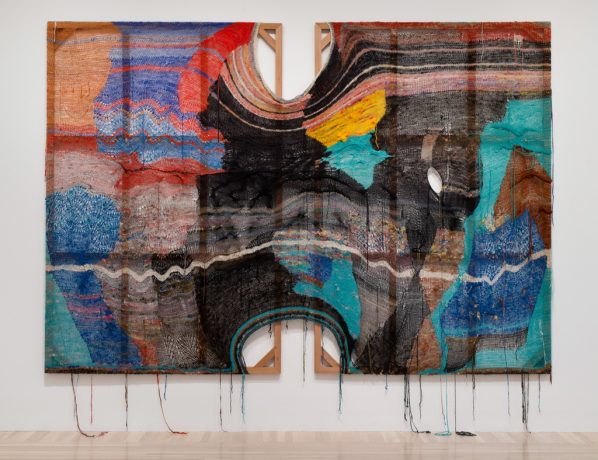
Channing Hansen, ’42′, 2014, Handspun and dyed Bluefaced Leicester, Cheviot, Corriedale, Icelandic, Merino, Mohair, Romney, Teeswater, and Wensleydale wools, Teeswater locks, yak down, holographic polymers, silk noils, Tencel, and cedar, 120 x 180 in. (304.8 x 457.2 cm). Private collection. Photo Credit: Photo by Heather Rasmussen, courtesy the artist.
Simon Lee Gallery, Hong Kong, is pleased to announce the first solo exhibition in Asia by Los Angeles-based artist Channing Hansen. In Pattern Recognition Hansen presents a new series of his signature hand-knitted textile-based works, which bring together craft and computation to explore theories related to the intersection of art, science and technology.
Hansen’s labour-intensive process sees him skirt, wash, dye, blend and spin the wool that he then uses to knit the works by hand, using a pattern that is determined by a computer-generated algorithm whose data set draws from a range of scientific concepts and mathematical formulae. Potentially encompassing an infinite combination of colours, fibres and patterns, this algorithm dictates the composition but the work’s appearance is not known until it is complete. Once finished, each knitted textile is stretched over a wooden frame; yet its appearance is provisional. Each cell, or ‘knit’, contains a multitude of possibilities – its shape, size and position on the textile grid are fixed by the frame but potentially flexible and subject to change over time.
Hansen’s knitted works tread the line between painting and sculpture, their web-like construction occasionally revealing the stretcher behind. Their relationship to craft may initially seem to be at odds with the scientific concepts informing the algorithm. However, bringing these two disciplines into dialogue allows Hansen to explore the tension between chaos and order, as the artist’s hand introduces human variability within an otherwise programmatic composition. This is evident in the forms his textiles evoke, which might resemble tendrils of DNA, crystalline structures, or biomorphic shapes.
The works in Pattern Recognition emerge from Hansen’s ongoing exploration of algorithms and the ways in which they exert an invisible influence on all elements of human life. Pattern recognition is an algorithmic process defined by computer science as the assignation or determination of identity, based on received data through the detection and delineation of patterns – and their relationships – within a sample. Hansen believes that human beings are evolutionarily hardwired to see patterns. As such, it comes as no surprise that visual patterns recur in the art of so many cultures. From ancient ceramics to contemporary anime, pattern fundamentally shapes perception.
American artist Robert Smithson famously explored pattern structures to reveal the mechanics of perception, notably in his work titled Enantiomorphic Chambers. Rather than reflected, the viewer that steps in front of the work sees their presence effectively cancelled through the precise positioning of mirrors, as Smithson claims, ‘eliminating the consciousness that regulates binary vision’. Combining the seemingly dichotomous languages of textile and computer code, Hansen’s new knitted works invite a meditation on pattern in a way that disrupts the compositional harmony and uniformity that is a hallmark of other textile techniques, such as jacquard-weaving or machine-knitting, with an unstable human element. While the algorithm they use is based on based on crystalline structures in homage to Smithson, their ‘patterns’ are randomised in each case to further disrupt the regularity of the textile grid.
About Channing HansenChanning Hansen was born in 1972 in Los Angeles, CA, where he lives and works. He graduated from the San Francisco Art Institute, San Francisco, CA, in 2007. In 2008, he attended the alternative pedagogical experiment known as the Mountain School of Art, in Los Angeles, CA, where he continues to lecture on topics related to science and art. Hansen has been the subject of solo exhibitions at Stephen Friedman Gallery, London, UK (2018, 2017); Marc Selwyn Fine Arts, Beverly Hills, CA (2018, 2016) and CRG Gallery, New York, NY (2017). Significant group exhibitions include ‘Inherent Structure’, Wexner Center for the Arts, Columbus, OH (2018); ‘Black & White & In Between: Contemporary Art from the Frederick R. Weisman Art Foundation’, Carnegie Art Museum, Oxnard, CA (2018); ’99 Cents or Less’, Museum of Contemporary Art, Detroit, MI (2017); ‘Intertwined’, The Institute of Fine Arts, New York University, NY (2016) and ‘Made in LA’, Hammer Museum, Los Angeles, CA (2014). His work is included in a number of prominent international collections, including the Stedelijk Museum, Amsterdam, The Netherlands; The Ahmanson Foundation, Los Angeles, CA; Hammer Museum, Los Angeles, CA; Los Angeles County Museum of Art, Los Angeles, CA, and the Frederick R. Weisman Foundation, Los Angeles, CA.
About Simon Lee GalleryFounded in Mayfair, London in 2002, Simon Lee Gallery represents artists of diverse generations whose practices range from sculpture and painting to video and photography and who share a broad interest in an exploration of the conceptual. Aiming to provide a significant international audience for its artists, the gallery also regularly punctuates its programme with historical exhibitions and curated group shows, which present shifts in contemporary art practice and thought, whilst broadening the dialogue with artists outside of the gallery’s core programme. In addition to its UK activity, in 2012 the gallery opened a space in Hong Kong, helping to introduce its artists to a wider public in Asia, with a fully independent programme. In 2014, Simon Lee Gallery opened an office and private viewing space. In 2017, the New York space was re-launched with an independent year-round programme of exhibitions and events, showcasing the work of emerging and established artists in dynamic group and solo exhibitions.
About the exhibition
Dates: 2019.01.11 - 2019.02.11
Venue: Simon Lee Gallery
Address: 304, 3F The Pedder Building 12 Pedder Street Central, Hong Kong
Courtesy of the artist and Simon Lee Gallery, for further information please visit www.simonleegallery.com.




























